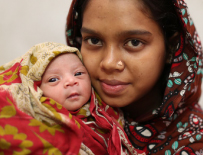DHAKA, Feb 22, 2018 (BSS) – Bangladesh has achieved major gains in
maternal and newborn survival, facility childbirth and skilled birth
attendance till now and this trend could be further improved by providing
nutritional supplements to pregnant mothers, their newborn babies and young
children.
A critical component of optimal maternal nutrition and health is
micronutrient intake. Mounting evidence suggests that micronutrient
supplements, in place of the current recommendation of iron-folic acid
supplements, offers greater benefits for both mother and baby.
High-quality maternal health care is necessary to address this burden and
implementation of WHO Safe Childbirth Checklist (SCC), whose items address
the major causes of maternal deaths, is hypothesized to improve adherence of
providers to essential childbirth practices.
The SCC was adapted for the local context through expert consultation
meetings, creating a total of 27 checklist items. WHO conducted a study as a
pre-post evaluation of SCC implementation and collected data of over 8 months
at the Magura District Hospital.
The WHO experts analyzed 468 direct observations of birth, main analysis
using 310 complete observations and sensitivity analysis with the additional
158 incomplete observations, from admission to discharge.
The primary outcome of interest was the number of essential childbirth
practices performed before compared to after SCC implementation. The change
was assessed using adjusted Poisson regression models accounting for
clustering by nurse-midwives.
After checklist introduction, significant improvements were observed: on
average, around 70% more of these safe childbirth practices were performed in
the follow-up period compared to baseline from 11 to 19 out of 27 practices.
Substantial increases were seen in communication between nurse-midwives
and mothers (counseling), and in management of complications including
rational use of medicines. In multivariable models that included
characteristics of the mothers and of the nurse-midwives, the rate of
delivering the essential childbirth practices was 1.71 times greater in the
follow-up compared to baseline.
Implementation of SCC has the potential to improve essential childbirth
practice in resource-poor settings like Bangladesh. This study emphasizes the
need for health system strengthening in order to achieve the full advantages
of SCC implementation.
As the end of MDGs era offers an opportunity to examine successes and
failures in the global health and to identify priorities for the future, the
world achieved overall major gains in maternal and child survival and in
coverage of facility-based childbirth and skilled birth attendance.
Many women and newborns, however, continue to die during and shortly after
childbirth, and disparities persist across countries as well as across groups
within countries. This suggests that the global strategy, which has focused
on increasing coverage of skilled birth attendance, did not eliminate all
excess burden.
WHO says high-quality maternal health care is essential for reducing
excess mortality. Mirroring global trends, Bangladesh made a great progress
towards MDG 4 and 5 targets and now stepped into fulfilling the challenges of
SDG targets.
While the current neonatal mortality rate of 28 per 1000 live births has
been lower than the target of 48 deaths per 1000 live births, its maternal
mortality ratio (MMR) decreased from 574 maternal deaths per 100,000 live
births in 1991 to 176 deaths per 100,000 live births in 2015.
The good news is that use of facility delivery has been increased in this
period and much more facilities are being provided now to ensure safe
childbirth and sound maternal health by the Ministry of Hearth and Family
Welfare. High-quality childbirth care requires facility and availability of
human resources with skills and capacity to effectively manage uncomplicated
and complicated childbirth events.
“When it comes to newborn deaths, the global trends are alarmingly high,
particularly among the world’s poorest countries. Global data indicates that
2.6 million newborn babies die every year and the average newborn mortality
rate in low-income countries are way higher compared to high-income
countries. Newborns from low-income countries are 50 times more likely to
die,” said Edouard Beigbeder, the UNICEF Chief in Bangladesh.
Compared to any other low-income countries, he said, no doubt, Bangladesh
has done quite well in relation to many development indicators, including its
progress in neonatal mortality. A sharp decline is evident from the data:
241,000 newborns died in 1990 and then this data went down to 62,000 in 2016.
But the question is, the UNICEF Chief sought to know, whether this
progress has been made in all the regions of country. Has its impact reached
out to every newborn? A recent UNICEF report reveals that despite well-
performing public health programmes, Bangladesh is still among the 10
countries with the highest number of newborn deaths in 2016, and newborn
mortality rates.
WHO suggests the health professionals to advise healthy pregnant women
that the duration of labour varies greatly from one woman to another. While
most women want a natural labour and birth, they also acknowledge that birth
can be an unpredictable and risky event and that close monitoring and
sometimes medical interventions may be necessary.



